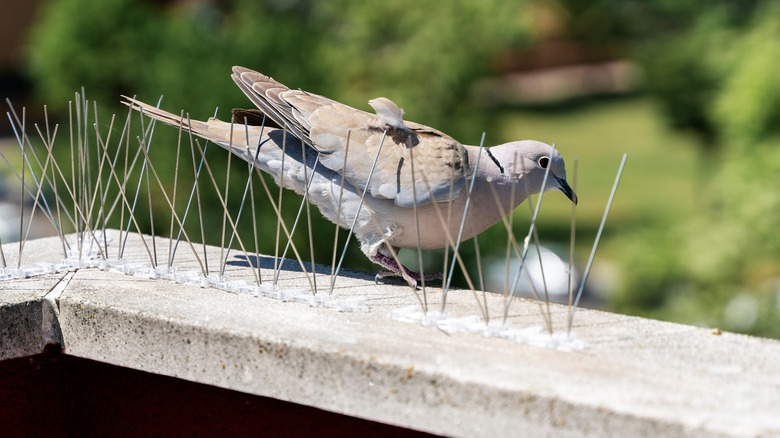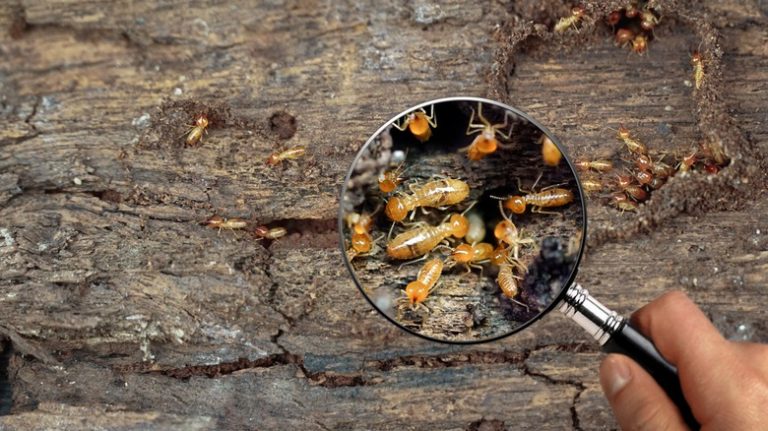We may receive a commission on purchases made from links.
One of the most rewarding activities a homeowner can enjoy is growing a healthy garden full of fresh fruits and vegetables. Unfortunately, you aren’t the only one who enjoys snacking on your home-grown treats. As enjoyable as it is to have beautiful songbirds singing in your backyard, you don’t want them sneaking bites out of your food. Even if you don’t have a garden, you may want to avoid a flock of birds flying in your yard for several reasons. Thankfully, there are multiple methods you can use to deter birds from stopping by your home.
It can be challenging to determine which tricks will work best between visual, audio, and barriers you can use. To help, we’ve rounded up the most beneficial techniques backed by tests and academic studies, though you’ll probably want to implement two or more at a time. According to a study published by the University of California, Davis, you’ll have the most success by combining several methods to get the best garden protection. No matter which of these approaches you use, ensure you keep the birds’ safety in mind. You never want to set out traps that could injure or kill our feathered friends, especially since it’s illegal to harm several protected species.
Place bird netting around plants

If you have a garden with food you want to protect, creating a barrier will be one of the best ways to prevent birds from dropping in for a bite. According to the University of Minnesota Extension’s Commercial Fruit and Vegetable Program, bird netting is the most effective safeguard against crops like berries. Because it physically prevents birds from reaching the plants, it’s nearly 100% effective when properly placed. However, you don’t want to leave it and forget it. Over time, animals may successfully create a hole, allowing birds to sneak in. So, inspecting the net regularly is crucial to ensure there’s no damage that could allow a flying intruder to find its way in.
First, you need to identify which vegetation requires complete protection. Not only does this reduce the amount of netting you need to purchase, but it also allows birds to inhabit parts of the garden where they’re beneficial. You’ll also want to choose high-quality netting such as nylon, like this $13 netting from Amazon, rather than cheaper options that may deteriorate more quickly. Choose a smaller gauge, no larger than an inch, to keep birds out while preventing any avian injuries. Secondly, a sturdy frame is a must to ensure you have solid support around your chosen area. Opt for PVC, wooden stakes, galvanized steel, or sturdy wire to construct the structure. When building your barrier, you’ll want to ensure you leave plenty of room for plants to grow fully.
Hang reflective tape

Reflective tape, also called bird or flash tape, aids in deterring birds from landing on nearby surfaces. It works by reflecting an ultraviolet light that disorients birds, keeping them away from buildings and gardens near where the tape is hung. Birdful shared several studies showing the effectiveness of this deterrent in several scenarios. While it’s important to note that this isn’t a permanent solution, the method does make taped areas less attractive and reduces overall bird activity. According to the scientific journal MDPI, the noise caused by wind hitting the tape adds an auditory element, making it even more effective. However, they also state that some birds may get used to this method over time.
Although the name has the word “tape” in it, the material isn’t sticky on either side. There are several ways to install it around your home and garden. One method is to cut 3-inch strips and attach them to 6- to 8-inch pieces of string. Tie these to a fence, post, or tree in the area you want to prevent birds from coming in. The reflective material will flap in the wind, keeping them away from that space. You can also place stakes to attach the flash tape at 15- to 20-foot intervals to keep the feathered animals at bay.
Put up scare balloons

Jaanalisette/Getty Images
Scare balloons are another visual tactic that works well to repel some species of birds. As the name suggests, these aren’t your average party favors; they are deterrents with threatening faces designed to frighten birds away. There’s some discrepancy in the effectiveness of using these menacing inflatables, with studies showing that they work well in some cases but not all. So, you’ll need to test it out for yourself to determine if they keep certain species of birds away. Almanac suggests adding reflective tape to the bottom to give the balloons a more powerful effect.
Thankfully, hanging up these bird repellants is simple and doesn’t require a significant investment. First, place posts around your garden; the more, the better. Then, all you need to do is tie the balloons and ribbons, if you want the added benefit, to the stakes. You’ll need to relocate the inflatables every few days; otherwise, the birds may become used to them, weakening their effect. Many sources suggest adding another element, like a sound deterrent, to get the most bird-repelling bang for your buck.
Build a barrier

FotoDuets/Shutterstock
If you’re only tending to seedlings, creating mini barriers is an effective way to protect small plants. You’ll need to get a little creative, but placing a divider between what you want to keep safe and any outdoor nuisances is one of your best bets. The only downside to this method is you’ll likely need to purchase bird netting once the crops outgrow the smaller enclosures. It’s also crucial to ensure anything you add is secure to avoid smashing your sensitive greens while keeping animals from sneaking in.
There are several ways you can add barriers to smaller fruit and vegetable plants. If you have plastic crates, you can place them over the plants to help keep birds and other critters away. When using this technique, use a crate with plenty of holes that will allow sunlight to reach the vulnerable seedlings. Another trick is to tie chicken wire to the outside of a tomato cage, creating a sturdy cone that surrounds your outdoor plant babies.
Set up porcupine wire

Chemari/Shutterstock
While watching feathered friends fly around the yard can be entertaining, their droppings can become quite a nuisance over time. There are likely several areas around your home where birds enjoy landing, which also means there’s a lot of required cleanup. Aptly named, porcupine wire is a set of spikes that stick out in all different directions, giving the appearance of the familiar pointy animal. Because it’s sharp, it’ll encourage the birds to find another place to land or roost. However, if your yard is prone to starlings, they can easily squeeze through larger set spikes, making it an enticing place to cozy up.
This method was created for use on horizontal surfaces like ledges and likely won’t benefit your garden. Luckily, it’s pretty easy to install and has a long lifespan, so once you have it in place, you’ll only need to deal with cleaning it occasionally. There are a few different types of this physical barrier, so each brand will have different installation instructions. However, for most products, you can secure it to surfaces you want to keep bird-free using a staple gun or a drill.
Add a scarecrow

Meaw_stocker/Shutterstock
Scarecrows have been around pretty much as long as gardening has, dating back to ancient Egypt, and they’re still among the most common bird repellants gardeners use worldwide. Despite their popularity, the effectiveness of these creepy figures depends on the species you’re trying to keep away. While the traditional scarecrow keeps away pests like crows and blackbirds, the effect is often temporary. Luckily, there are a few tricks you can use to make them scarier for longer.
Like other visual deterrents, they work best when paired with audio. According to multiple studies, the best scarecrows also incorporate a lot of movement Over time, birds will become less guarded around any non-moving objects, rendering them ineffective. Flailing arms, moving heads, and other similar attributes keep the birds guessing rather than concluding the human-like statue is non-threatening. Birds are intelligent, so you’ll have to put in some work to trick them. Moving the scarecrow, changing its clothes, or repositioning are a few ways to continue adding the element of surprise.
Install flashing lights

Virrage Images/Shutterstock
It’s unclear why birds get freaked out by lighting, though it seems to be an effective repellent, according to a few studies. Some theorize the brightness is disorienting, causing them to want to escape in the other direction. Others believe its effect is due to birds learning that light signifies danger due to aircraft and cars. It’s important to note that more research needs to be done to understand which types of lights work best, which species they affect, and their overall effectiveness. As of now, most of the knowledge we have comes from bird-related hazards in the aircraft space.
This method works best for night-feeding birds, so you’ll likely need another deterrent for those who hang out during the day. Similar to other visual scares, the more movement you can add, the better. Blinding lights with a repetitive flash, bright changing colors, or rotating fixtures will benefit you the most. While some birds may be scared off by a harsh spotlight, still lighting may attract other species. Unfortunately, this means you’ll need to install lighting that will be distracting not only for nighttime flyers but also potentially for you and your neighbors. So, you’ll only want to add this element to areas where it doesn’t irritate you or the friendly family across the street.
Audible deterrents

matteoj/Shutterstock
Birds use their sense of sight and hearing to determine if danger is nearby, so adding some predatory sound effects, such as eagle calls, could encourage the creatures to fly the other way. While audio may work independently, you’ll have a better chance of keeping birds away from your property if you give them something scary to visually encounter in addition to the alarming noise. For example, adding loud sounds to a moving animal figure or scare balloon will offer several cues to suggest they’re in danger. However, you may want to avoid this method during nesting season, as mothers may attempt to fight the threat to protect their young.
There are multiple products on the market that you can purchase, though most audio-only systems have mixed reviews. One option that has gotten some praise is the 2-Pack Hausse Horned Owl Deterrent, with some reviewers suggesting it worked well to scare birds out of their yards. You can also record animal sounds from websites like YouTube to project over speakers in any area you want to keep bird-free. However, you’ll need to check your local laws, as some states prohibit loud noises like audio deterrents, as they can be a nuisance to the neighborhood.




